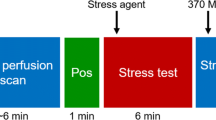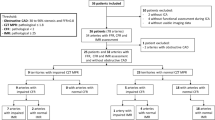Abstract
Purpose
We aimed to assess normal values for quantified myocardial blood flow (MBF) on a hybrid PET/coronary-CT scanner and to test their diagnostic performance in patients with suspected CAD.
Materials and Methods
Patients underwent 82Rb-PET/CT and integrated CT-based coronary angiography (CCTA) and were classified as normal (no stenosis), with non-obstructive stenosis (< 50%) and with CAD (≥ 50%). Global and regional stress MBF (sMBF), rest MBF and myocardial flow reserve (MFR) were calculated. Ischemia was defined as SDS ≥ 2, severe ischemia as SDS ≥ 7.
Results
357 consecutive patients were included. Global sMBF and MFR were higher in normal patients than in patients with CAD (3.61 ± 0.71 vs 3.04 ± 0.77, P < 0.0001; 3.08 ± 0.84 vs 2.68 ± 0.79, P = 0.0001), but not different compared to patients with non-obstructive stenosis (3.61 ± 0.71 vs 3.43 ± 0.69, P = 0.052; 3.08 ± 0.84 vs 2.99 ± 0.82, P = 0.45). sMBF yielded superior accuracy over MFR in identifying both ischemia (AUC 0.74 vs 0.62, P = 0.003) and severe ischemia (AUC 0.88 vs 0.78, P = 0.012). Optimal threshold for global sMBF to rule out myocardial ischemia was 3.5 mL g−1 min−1.
Conclusions
Normal quantitative values are provided. Global sMBF provided higher diagnostic accuracy than MFR. Using sMBF-threshold of 3.5 mL·g−1·min−1 on 82Rb-PET/CT yielded similar NPV (96%) as CCTA to rule out CAD. Hence, resting scan could be omitted in patients with sMBF values above reference.




Similar content being viewed by others
Abbreviations
- CCTA:
-
CT-based coronary angiography
- LAD:
-
Left anterior descending artery
- RCA:
-
Right coronary artery
- RCX:
-
Ramus circumflexus (left circumflex artery)
- sMBF:
-
Stress myocardial blood flow
- rMBF:
-
Rest myocardial blood flow
- MBF:
-
Myocardial blood flow
- MFR:
-
Myocardial flow reserve
- PPV/NPV:
-
Positive/negative predictive value
- SRS/SSS/SDS:
-
Summed rest/stress/difference score
References
Flotats A, Bravo PE, Fukushima K, Chaudhry MA, Merrill J, Bengel FM. 82Rb PET myocardial perfusion imaging is superior to 99mTc-labelled agent SPECT in patients with known or suspected coronary artery disease. Eur J Nucl Med Mol Imaging. 2012;39:1233-9.
Bengel FM, Higuchi T, Javadi MS, Lautamäki R. Cardiac positron emission tomography. J Am Coll Cardiol. 2009;54:1-15.
Sunderland JJ, Pan X-B, Declerck J, Menda Y. Dependency of cardiac rubidium-82 imaging quantitative measures on age, gender, vascular territory, and software in a cardiovascular normal population. J Nucl Cardiol Off Publ Am Soc Nucl Cardiol. 2015;22:72-84.
Prior JO, Allenbach G, Valenta I, et al. Quantification of myocardial blood flow with 82Rb positron emission tomography: Clinical validation with 15O-water. Eur J Nucl Med Mol Imaging. 2012;39:1037-47.
Danad I, Uusitalo V, Kero T, et al. Quantitative assessment of myocardial perfusion in the detection of significant coronary artery disease. J Am Coll Cardiol. 2014;64:1464-75.
Arbab-Zadeh A, Di Carli MF, Cerci R, et al. Accuracy of computed tomographic angiography and single-photon emission computed tomography-acquired myocardial perfusion imaging for the diagnosis of coronary artery disease. Circ Cardiovasc Imaging. 2015;8:e003533.
Tahari AK, Lee A, Rajaram M, et al. Absolute myocardial flow quantification with (82)Rb PET/CT: Comparison of different software packages and methods. Eur J Nucl Med Mol Imaging. 2014;41:126-35.
Fukushima K, Javadi MS, Higuchi T, et al. Prediction of short-term cardiovascular events using quantification of global myocardial flow reserve in patients referred for clinical 82Rb PET perfusion imaging. J Nucl Med Off Publ Soc Nucl Med. 2011;52:726-32.
Ziadi MC, Dekemp RA, Williams KA, et al. Impaired myocardial flow reserve on rubidium-82 positron emission tomography imaging predicts adverse outcomes in patients assessed for myocardial ischemia. J Am Coll Cardiol. 2011;58:740-8.
Herzog BA, Husmann L, Valenta I, et al. Long-term prognostic value of 13N-ammonia myocardial perfusion positron emission tomography added value of coronary flow reserve. J Am Coll Cardiol. 2009;54:150-6.
Stuijfzand WJ, Uusitalo V, Kero T, et al. Relative flow reserve derived from quantitative perfusion imaging may not outperform stress myocardial blood flow for identification of hemodynamically significant coronary artery disease. Circ Cardiovasc Imaging. 2015. https://doi.org/10.1161/CIRCIMAGING.114.002400.
Lortie M, Beanlands RSB, Yoshinaga K, Klein R, DaSilva JN, deKemp RA. Quantification of myocardial blood flow with 82Rb dynamic PET imaging. Eur J Nucl Med Mol Imaging. 2007;34:1765-74.
Czernin J, Muller P, Chan S, et al. Influence of age and hemodynamics on myocardial blood flow and flow reserve. Circulation. 1993;88:62-9.
Hansen CL, Goldstein RA, Akinboboye OO, et al. Myocardial perfusion and function: Single photon emission computed tomography. J Nucl Cardiol Off Publ Am Soc Nucl Cardiol. 2007;14:e39-60.
American Heart Association Writing Group on Myocardial Segmentation and Registration for Cardiac Imaging, Cerqueira MD, Weissman NJ, et al. Standardized myocardial segmentation and nomenclature for tomographic imaging of the heart: A statement for healthcare professionals from the Cardiac Imaging Committee of the Council on Clinical Cardiology of the American Heart Association. Circulation. 2002;105:539-542.
Knuuti J, Kajander S, Mäki M, Ukkonen H. Quantification of myocardial blood flow will reform the detection of CAD. J Nucl Cardiol. 2009;16:497-506.
Caobelli F. Anatomical and functional assessment of coronary artery disease in patients with stable angina: Which is the gold standard? J Nucl Cardiol. 2019;9:S26-35.
Tonino PA, Fearon WF, De Bruyne B, et al. Angiographic versus functional severity of coronary artery stenoses in the FAME study: fractional flow reserve versus angiography in multivessel evaluation. J Am Coll Cardiol. 2010;55:2816-21.
Gaur S, Øvrehus KA, Dey D, et al. Coronary plaque quantification and fractional flow reserve by coronary computed tomography angiography identify ischaemia-causing lesions. Eur Heart J. 2016;37:1220-7.
Toth G, Hamilos M, Pyxaras S, et al. Evolving concepts of angiogram: fractional flow reserve discordances in 4000 coronary stenoses. Eur Heart J. 2014;35:2831-8.
Hoffmann U, Bamberg F, Chae CU, et al. Coronary computed tomography angiography for early triage of patients with acute chest pain. J Am Coll Cardiol. 2009;53:1642-50.
Caobelli F. Left ventricular segmentation in myocardial perfusion positron emission tomography: Tailor-made or prêt-à-porter? Eur Heart J Cardiovasc Imaging. 2019;20:502-3.
Slomka PJ, Alexanderson E, Jácome R, et al. Comparison of clinical tools for measurements of regional stress and rest myocardial blood flow assessed with 13N-ammonia PET/CT. J Nucl Med Off Publ Soc Nucl Med. 2012;53:171-81.
Nesterov SV, Deshayes E, Sciagrà R, et al. Quantification of myocardial blood flow in absolute terms using 82Rb PET imaging. JACC Cardiovasc Imaging. 2014;7:1119-27.
Acknowledgements
We greatly appreciate the help and assistance of our excellent technicians.
Disclosure
Martin T. Freitag, Jens Bremerich, Damian Wild, Philip Haaf and Michael Zellweger report no disclosures relevant to the manuscript. Federico Caobelli received academic grant support from GE Healthcare and Tillots AG and speaker honoraria from Siemens, for matters not related to the current study. All the authors declared no conflicts of interest.
Ethical Approval
All procedures performed in studies involving human participants were in accordance with the ethical standards of the institutional and/or national research committee and with the principles of the 1964 Declaration of Helsinki and its later amendments or comparable ethical standards. A formal approval from the local Ethical Board was obtained for the present study (Req-2019-00447).
Author information
Authors and Affiliations
Corresponding author
Additional information
Publisher's Note
Springer Nature remains neutral with regard to jurisdictional claims in published maps and institutional affiliations.
The authors have also provided an audio summary of the article, which is available to download as ESM, or to listen to via the JNC/ASNC Podcast.
All editorial decisions for this article, including selection of reviewers and the final decision, were made by guest editor Henry Gewirtz, MD, PhD.
The authors of this article have provided a PowerPoint file, available for download at SpringerLink, which summarises the contents of the paper and is free for re-use at meetings and presentations. Search for the article DOI on SpringerLink.com.
Electronic Supplementary Material
Below is the link to the electronic supplementary material.
Rights and permissions
About this article
Cite this article
Freitag, M.T., Bremerich, J., Wild, D. et al. Quantitative myocardial perfusion 82Rb-PET assessed by hybrid PET/coronary-CT: Normal values and diagnostic performance. J. Nucl. Cardiol. 29, 464–473 (2022). https://doi.org/10.1007/s12350-020-02264-4
Received:
Accepted:
Published:
Issue Date:
DOI: https://doi.org/10.1007/s12350-020-02264-4




